Business Law: Contract, Negligence, and Liability Analysis
VerifiedAdded on 2019/12/03
|12
|4839
|138
Report
AI Summary
This report delves into the multifaceted aspects of contract and negligence within a business context. It begins by outlining the essential elements required for the formation of a valid contract, such as offer and acceptance, consideration, legal obligation, and the intention of legal facts. The report then discusses various types of contracts, including face-to-face, written, and distance selling contracts, along with their respective impacts. Through case studies, the report applies contract elements to scenarios involving agreements between parties. It also explains promissory estoppel, analyzing terms in contracts and evaluating the effect of expressed and implied terms. The report further examines the validity of exclusion clauses and the concept of vicarious liability. The report also explores the tort of negligence, providing advice on recovering losses and contrasting contractual liability with tort liability, including relevant cases like 'Donoghue v Stevenson' and 'Ryland v Fletcher.' Finally, the report discusses occupier's duty of care to visitors and when businesses are and are not vicariously liable for employee actions.
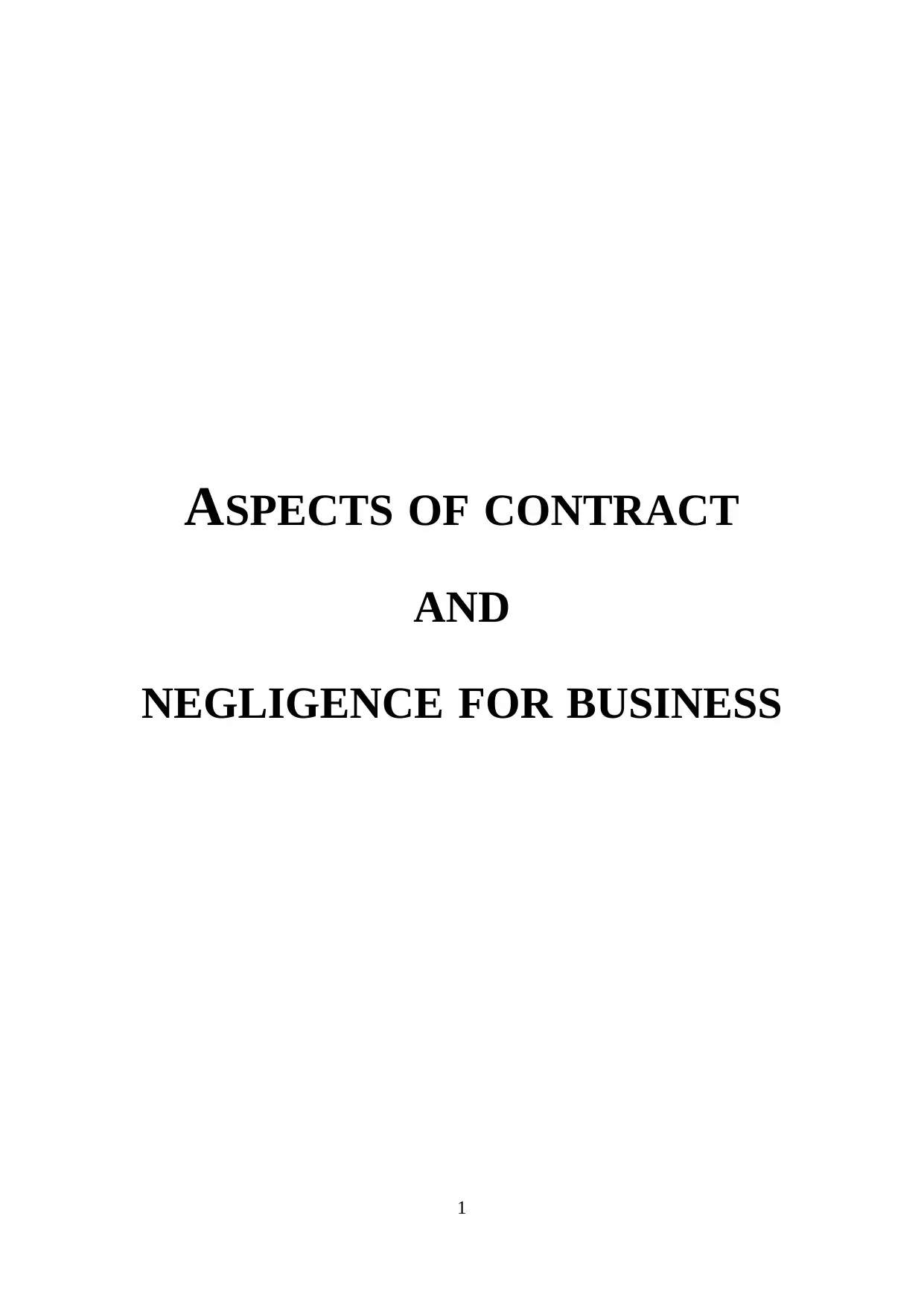
ASPECTS OF CONTRACT
AND
NEGLIGENCE FOR BUSINESS
1
AND
NEGLIGENCE FOR BUSINESS
1
Paraphrase This Document
Need a fresh take? Get an instant paraphrase of this document with our AI Paraphraser
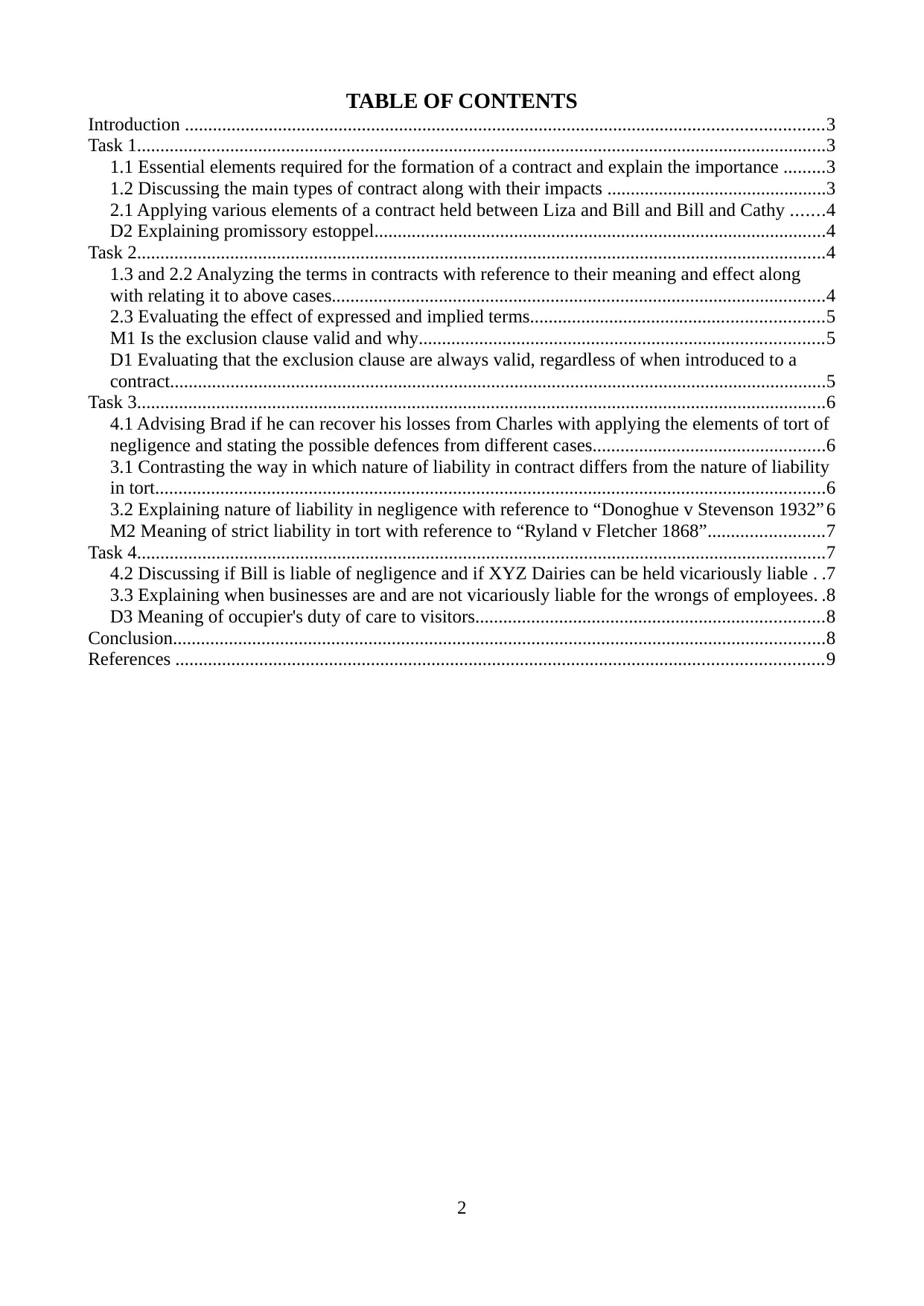
TABLE OF CONTENTS
Introduction .........................................................................................................................................3
Task 1....................................................................................................................................................3
1.1 Essential elements required for the formation of a contract and explain the importance .........3
1.2 Discussing the main types of contract along with their impacts ...............................................3
2.1 Applying various elements of a contract held between Liza and Bill and Bill and Cathy .......4
D2 Explaining promissory estoppel.................................................................................................4
Task 2....................................................................................................................................................4
1.3 and 2.2 Analyzing the terms in contracts with reference to their meaning and effect along
with relating it to above cases..........................................................................................................4
2.3 Evaluating the effect of expressed and implied terms...............................................................5
M1 Is the exclusion clause valid and why.......................................................................................5
D1 Evaluating that the exclusion clause are always valid, regardless of when introduced to a
contract.............................................................................................................................................5
Task 3....................................................................................................................................................6
4.1 Advising Brad if he can recover his losses from Charles with applying the elements of tort of
negligence and stating the possible defences from different cases..................................................6
3.1 Contrasting the way in which nature of liability in contract differs from the nature of liability
in tort................................................................................................................................................6
3.2 Explaining nature of liability in negligence with reference to “Donoghue v Stevenson 1932” 6
M2 Meaning of strict liability in tort with reference to “Ryland v Fletcher 1868”.........................7
Task 4....................................................................................................................................................7
4.2 Discussing if Bill is liable of negligence and if XYZ Dairies can be held vicariously liable . .7
3.3 Explaining when businesses are and are not vicariously liable for the wrongs of employees. .8
D3 Meaning of occupier's duty of care to visitors...........................................................................8
Conclusion............................................................................................................................................8
References ...........................................................................................................................................9
2
Introduction .........................................................................................................................................3
Task 1....................................................................................................................................................3
1.1 Essential elements required for the formation of a contract and explain the importance .........3
1.2 Discussing the main types of contract along with their impacts ...............................................3
2.1 Applying various elements of a contract held between Liza and Bill and Bill and Cathy .......4
D2 Explaining promissory estoppel.................................................................................................4
Task 2....................................................................................................................................................4
1.3 and 2.2 Analyzing the terms in contracts with reference to their meaning and effect along
with relating it to above cases..........................................................................................................4
2.3 Evaluating the effect of expressed and implied terms...............................................................5
M1 Is the exclusion clause valid and why.......................................................................................5
D1 Evaluating that the exclusion clause are always valid, regardless of when introduced to a
contract.............................................................................................................................................5
Task 3....................................................................................................................................................6
4.1 Advising Brad if he can recover his losses from Charles with applying the elements of tort of
negligence and stating the possible defences from different cases..................................................6
3.1 Contrasting the way in which nature of liability in contract differs from the nature of liability
in tort................................................................................................................................................6
3.2 Explaining nature of liability in negligence with reference to “Donoghue v Stevenson 1932” 6
M2 Meaning of strict liability in tort with reference to “Ryland v Fletcher 1868”.........................7
Task 4....................................................................................................................................................7
4.2 Discussing if Bill is liable of negligence and if XYZ Dairies can be held vicariously liable . .7
3.3 Explaining when businesses are and are not vicariously liable for the wrongs of employees. .8
D3 Meaning of occupier's duty of care to visitors...........................................................................8
Conclusion............................................................................................................................................8
References ...........................................................................................................................................9
2
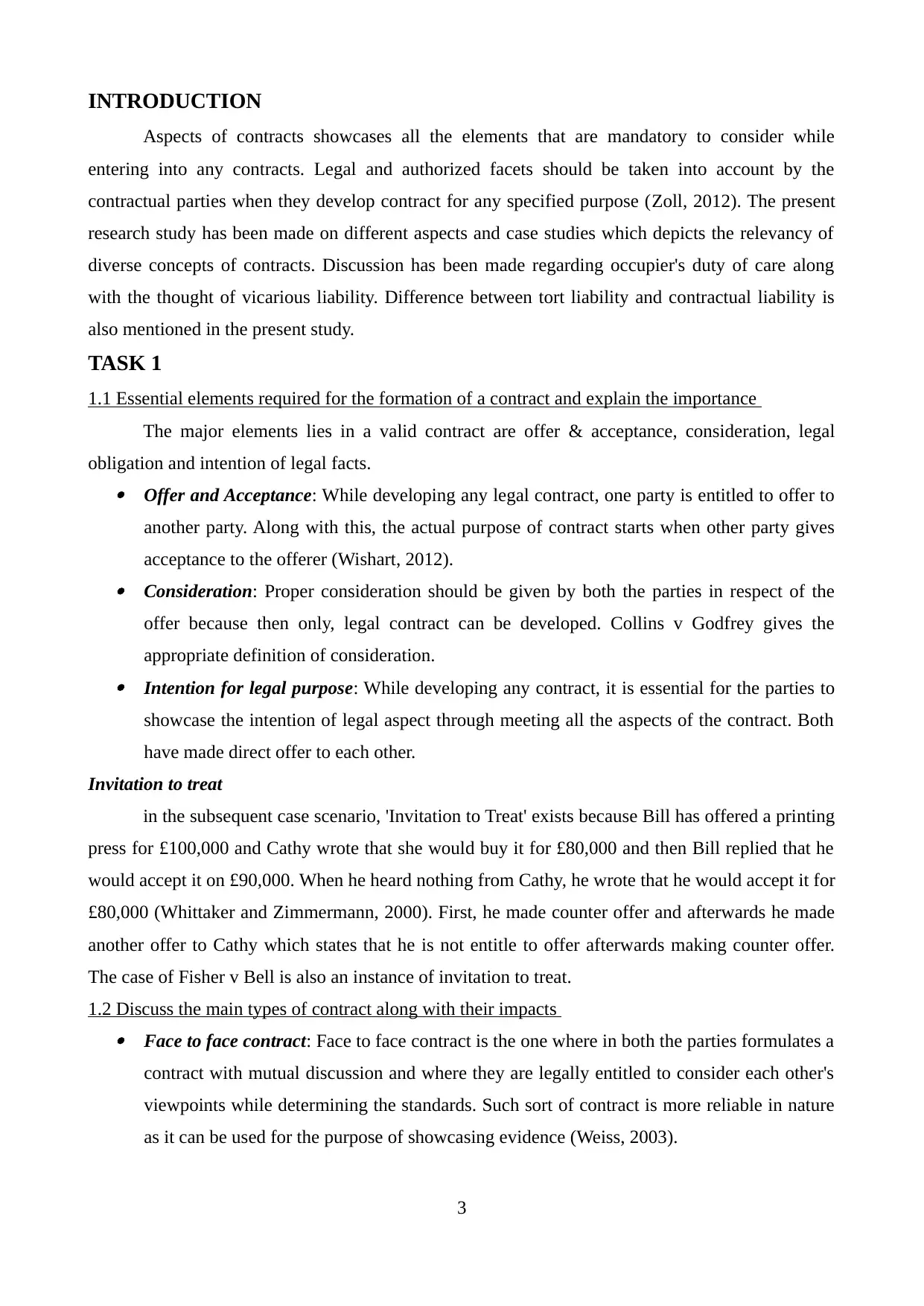
INTRODUCTION
Aspects of contracts showcases all the elements that are mandatory to consider while
entering into any contracts. Legal and authorized facets should be taken into account by the
contractual parties when they develop contract for any specified purpose (Zoll, 2012). The present
research study has been made on different aspects and case studies which depicts the relevancy of
diverse concepts of contracts. Discussion has been made regarding occupier's duty of care along
with the thought of vicarious liability. Difference between tort liability and contractual liability is
also mentioned in the present study.
TASK 1
1.1 Essential elements required for the formation of a contract and explain the importance
The major elements lies in a valid contract are offer & acceptance, consideration, legal
obligation and intention of legal facts. Offer and Acceptance: While developing any legal contract, one party is entitled to offer to
another party. Along with this, the actual purpose of contract starts when other party gives
acceptance to the offerer (Wishart, 2012). Consideration: Proper consideration should be given by both the parties in respect of the
offer because then only, legal contract can be developed. Collins v Godfrey gives the
appropriate definition of consideration. Intention for legal purpose: While developing any contract, it is essential for the parties to
showcase the intention of legal aspect through meeting all the aspects of the contract. Both
have made direct offer to each other.
Invitation to treat
in the subsequent case scenario, 'Invitation to Treat' exists because Bill has offered a printing
press for £100,000 and Cathy wrote that she would buy it for £80,000 and then Bill replied that he
would accept it on £90,000. When he heard nothing from Cathy, he wrote that he would accept it for
£80,000 (Whittaker and Zimmermann, 2000). First, he made counter offer and afterwards he made
another offer to Cathy which states that he is not entitle to offer afterwards making counter offer.
The case of Fisher v Bell is also an instance of invitation to treat.
1.2 Discuss the main types of contract along with their impacts Face to face contract: Face to face contract is the one where in both the parties formulates a
contract with mutual discussion and where they are legally entitled to consider each other's
viewpoints while determining the standards. Such sort of contract is more reliable in nature
as it can be used for the purpose of showcasing evidence (Weiss, 2003).
3
Aspects of contracts showcases all the elements that are mandatory to consider while
entering into any contracts. Legal and authorized facets should be taken into account by the
contractual parties when they develop contract for any specified purpose (Zoll, 2012). The present
research study has been made on different aspects and case studies which depicts the relevancy of
diverse concepts of contracts. Discussion has been made regarding occupier's duty of care along
with the thought of vicarious liability. Difference between tort liability and contractual liability is
also mentioned in the present study.
TASK 1
1.1 Essential elements required for the formation of a contract and explain the importance
The major elements lies in a valid contract are offer & acceptance, consideration, legal
obligation and intention of legal facts. Offer and Acceptance: While developing any legal contract, one party is entitled to offer to
another party. Along with this, the actual purpose of contract starts when other party gives
acceptance to the offerer (Wishart, 2012). Consideration: Proper consideration should be given by both the parties in respect of the
offer because then only, legal contract can be developed. Collins v Godfrey gives the
appropriate definition of consideration. Intention for legal purpose: While developing any contract, it is essential for the parties to
showcase the intention of legal aspect through meeting all the aspects of the contract. Both
have made direct offer to each other.
Invitation to treat
in the subsequent case scenario, 'Invitation to Treat' exists because Bill has offered a printing
press for £100,000 and Cathy wrote that she would buy it for £80,000 and then Bill replied that he
would accept it on £90,000. When he heard nothing from Cathy, he wrote that he would accept it for
£80,000 (Whittaker and Zimmermann, 2000). First, he made counter offer and afterwards he made
another offer to Cathy which states that he is not entitle to offer afterwards making counter offer.
The case of Fisher v Bell is also an instance of invitation to treat.
1.2 Discuss the main types of contract along with their impacts Face to face contract: Face to face contract is the one where in both the parties formulates a
contract with mutual discussion and where they are legally entitled to consider each other's
viewpoints while determining the standards. Such sort of contract is more reliable in nature
as it can be used for the purpose of showcasing evidence (Weiss, 2003).
3
⊘ This is a preview!⊘
Do you want full access?
Subscribe today to unlock all pages.

Trusted by 1+ million students worldwide
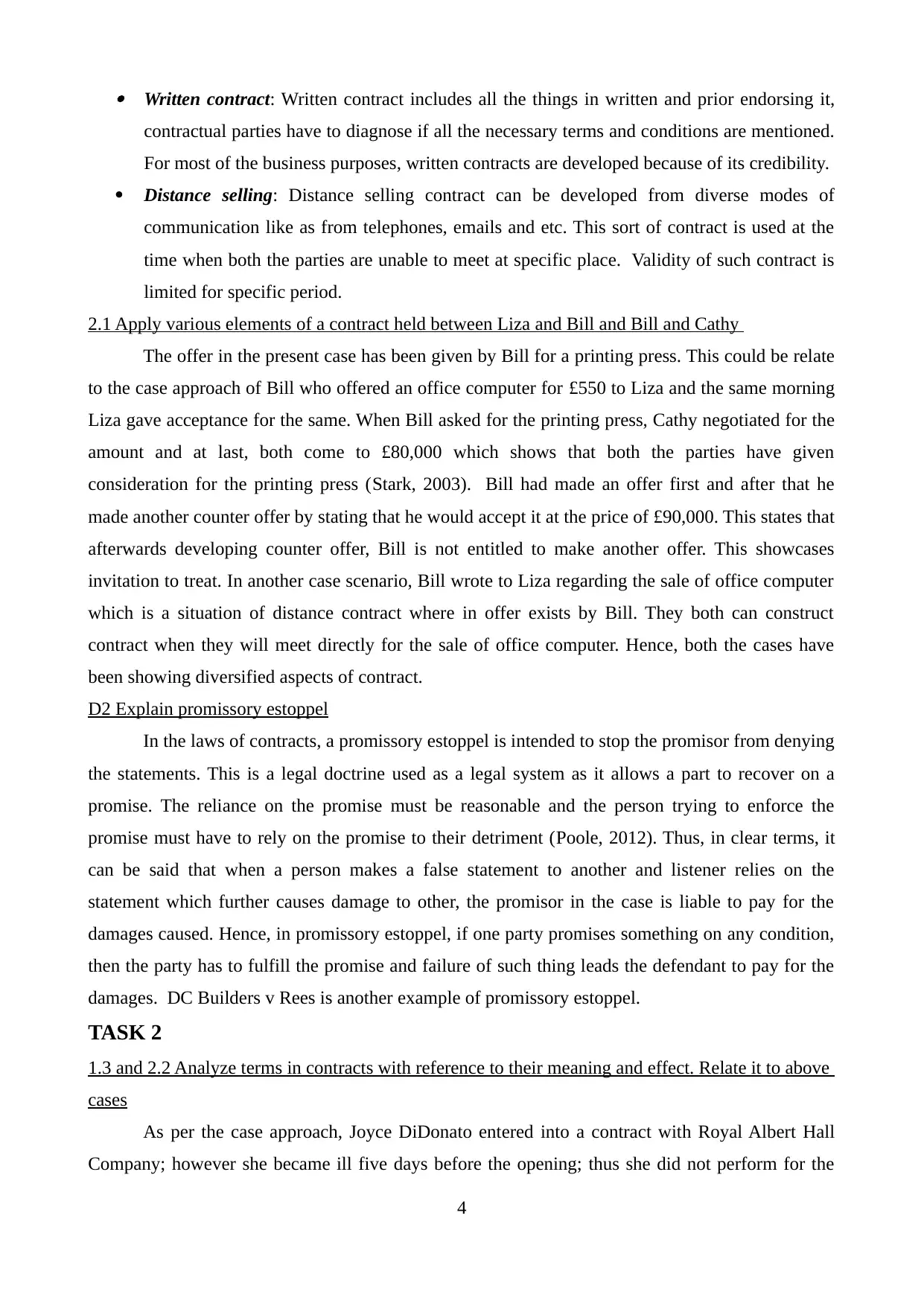
Written contract: Written contract includes all the things in written and prior endorsing it,
contractual parties have to diagnose if all the necessary terms and conditions are mentioned.
For most of the business purposes, written contracts are developed because of its credibility.
Distance selling: Distance selling contract can be developed from diverse modes of
communication like as from telephones, emails and etc. This sort of contract is used at the
time when both the parties are unable to meet at specific place. Validity of such contract is
limited for specific period.
2.1 Apply various elements of a contract held between Liza and Bill and Bill and Cathy
The offer in the present case has been given by Bill for a printing press. This could be relate
to the case approach of Bill who offered an office computer for £550 to Liza and the same morning
Liza gave acceptance for the same. When Bill asked for the printing press, Cathy negotiated for the
amount and at last, both come to £80,000 which shows that both the parties have given
consideration for the printing press (Stark, 2003). Bill had made an offer first and after that he
made another counter offer by stating that he would accept it at the price of £90,000. This states that
afterwards developing counter offer, Bill is not entitled to make another offer. This showcases
invitation to treat. In another case scenario, Bill wrote to Liza regarding the sale of office computer
which is a situation of distance contract where in offer exists by Bill. They both can construct
contract when they will meet directly for the sale of office computer. Hence, both the cases have
been showing diversified aspects of contract.
D2 Explain promissory estoppel
In the laws of contracts, a promissory estoppel is intended to stop the promisor from denying
the statements. This is a legal doctrine used as a legal system as it allows a part to recover on a
promise. The reliance on the promise must be reasonable and the person trying to enforce the
promise must have to rely on the promise to their detriment (Poole, 2012). Thus, in clear terms, it
can be said that when a person makes a false statement to another and listener relies on the
statement which further causes damage to other, the promisor in the case is liable to pay for the
damages caused. Hence, in promissory estoppel, if one party promises something on any condition,
then the party has to fulfill the promise and failure of such thing leads the defendant to pay for the
damages. DC Builders v Rees is another example of promissory estoppel.
TASK 2
1.3 and 2.2 Analyze terms in contracts with reference to their meaning and effect. Relate it to above
cases
As per the case approach, Joyce DiDonato entered into a contract with Royal Albert Hall
Company; however she became ill five days before the opening; thus she did not perform for the
4
contractual parties have to diagnose if all the necessary terms and conditions are mentioned.
For most of the business purposes, written contracts are developed because of its credibility.
Distance selling: Distance selling contract can be developed from diverse modes of
communication like as from telephones, emails and etc. This sort of contract is used at the
time when both the parties are unable to meet at specific place. Validity of such contract is
limited for specific period.
2.1 Apply various elements of a contract held between Liza and Bill and Bill and Cathy
The offer in the present case has been given by Bill for a printing press. This could be relate
to the case approach of Bill who offered an office computer for £550 to Liza and the same morning
Liza gave acceptance for the same. When Bill asked for the printing press, Cathy negotiated for the
amount and at last, both come to £80,000 which shows that both the parties have given
consideration for the printing press (Stark, 2003). Bill had made an offer first and after that he
made another counter offer by stating that he would accept it at the price of £90,000. This states that
afterwards developing counter offer, Bill is not entitled to make another offer. This showcases
invitation to treat. In another case scenario, Bill wrote to Liza regarding the sale of office computer
which is a situation of distance contract where in offer exists by Bill. They both can construct
contract when they will meet directly for the sale of office computer. Hence, both the cases have
been showing diversified aspects of contract.
D2 Explain promissory estoppel
In the laws of contracts, a promissory estoppel is intended to stop the promisor from denying
the statements. This is a legal doctrine used as a legal system as it allows a part to recover on a
promise. The reliance on the promise must be reasonable and the person trying to enforce the
promise must have to rely on the promise to their detriment (Poole, 2012). Thus, in clear terms, it
can be said that when a person makes a false statement to another and listener relies on the
statement which further causes damage to other, the promisor in the case is liable to pay for the
damages caused. Hence, in promissory estoppel, if one party promises something on any condition,
then the party has to fulfill the promise and failure of such thing leads the defendant to pay for the
damages. DC Builders v Rees is another example of promissory estoppel.
TASK 2
1.3 and 2.2 Analyze terms in contracts with reference to their meaning and effect. Relate it to above
cases
As per the case approach, Joyce DiDonato entered into a contract with Royal Albert Hall
Company; however she became ill five days before the opening; thus she did not perform for the
4
Paraphrase This Document
Need a fresh take? Get an instant paraphrase of this document with our AI Paraphraser
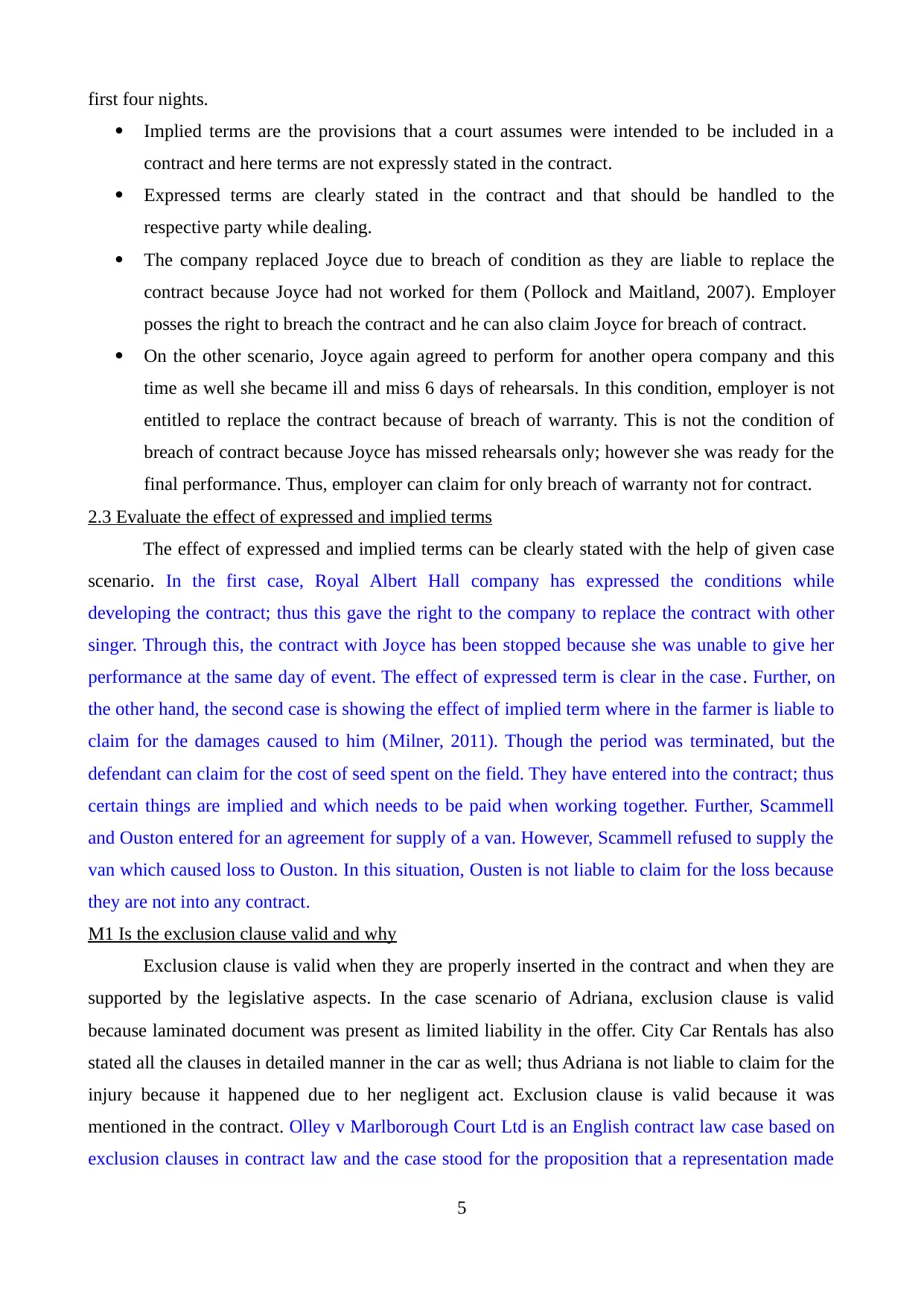
first four nights.
Implied terms are the provisions that a court assumes were intended to be included in a
contract and here terms are not expressly stated in the contract.
Expressed terms are clearly stated in the contract and that should be handled to the
respective party while dealing.
The company replaced Joyce due to breach of condition as they are liable to replace the
contract because Joyce had not worked for them (Pollock and Maitland, 2007). Employer
posses the right to breach the contract and he can also claim Joyce for breach of contract.
On the other scenario, Joyce again agreed to perform for another opera company and this
time as well she became ill and miss 6 days of rehearsals. In this condition, employer is not
entitled to replace the contract because of breach of warranty. This is not the condition of
breach of contract because Joyce has missed rehearsals only; however she was ready for the
final performance. Thus, employer can claim for only breach of warranty not for contract.
2.3 Evaluate the effect of expressed and implied terms
The effect of expressed and implied terms can be clearly stated with the help of given case
scenario. In the first case, Royal Albert Hall company has expressed the conditions while
developing the contract; thus this gave the right to the company to replace the contract with other
singer. Through this, the contract with Joyce has been stopped because she was unable to give her
performance at the same day of event. The effect of expressed term is clear in the case. Further, on
the other hand, the second case is showing the effect of implied term where in the farmer is liable to
claim for the damages caused to him (Milner, 2011). Though the period was terminated, but the
defendant can claim for the cost of seed spent on the field. They have entered into the contract; thus
certain things are implied and which needs to be paid when working together. Further, Scammell
and Ouston entered for an agreement for supply of a van. However, Scammell refused to supply the
van which caused loss to Ouston. In this situation, Ousten is not liable to claim for the loss because
they are not into any contract.
M1 Is the exclusion clause valid and why
Exclusion clause is valid when they are properly inserted in the contract and when they are
supported by the legislative aspects. In the case scenario of Adriana, exclusion clause is valid
because laminated document was present as limited liability in the offer. City Car Rentals has also
stated all the clauses in detailed manner in the car as well; thus Adriana is not liable to claim for the
injury because it happened due to her negligent act. Exclusion clause is valid because it was
mentioned in the contract. Olley v Marlborough Court Ltd is an English contract law case based on
exclusion clauses in contract law and the case stood for the proposition that a representation made
5
Implied terms are the provisions that a court assumes were intended to be included in a
contract and here terms are not expressly stated in the contract.
Expressed terms are clearly stated in the contract and that should be handled to the
respective party while dealing.
The company replaced Joyce due to breach of condition as they are liable to replace the
contract because Joyce had not worked for them (Pollock and Maitland, 2007). Employer
posses the right to breach the contract and he can also claim Joyce for breach of contract.
On the other scenario, Joyce again agreed to perform for another opera company and this
time as well she became ill and miss 6 days of rehearsals. In this condition, employer is not
entitled to replace the contract because of breach of warranty. This is not the condition of
breach of contract because Joyce has missed rehearsals only; however she was ready for the
final performance. Thus, employer can claim for only breach of warranty not for contract.
2.3 Evaluate the effect of expressed and implied terms
The effect of expressed and implied terms can be clearly stated with the help of given case
scenario. In the first case, Royal Albert Hall company has expressed the conditions while
developing the contract; thus this gave the right to the company to replace the contract with other
singer. Through this, the contract with Joyce has been stopped because she was unable to give her
performance at the same day of event. The effect of expressed term is clear in the case. Further, on
the other hand, the second case is showing the effect of implied term where in the farmer is liable to
claim for the damages caused to him (Milner, 2011). Though the period was terminated, but the
defendant can claim for the cost of seed spent on the field. They have entered into the contract; thus
certain things are implied and which needs to be paid when working together. Further, Scammell
and Ouston entered for an agreement for supply of a van. However, Scammell refused to supply the
van which caused loss to Ouston. In this situation, Ousten is not liable to claim for the loss because
they are not into any contract.
M1 Is the exclusion clause valid and why
Exclusion clause is valid when they are properly inserted in the contract and when they are
supported by the legislative aspects. In the case scenario of Adriana, exclusion clause is valid
because laminated document was present as limited liability in the offer. City Car Rentals has also
stated all the clauses in detailed manner in the car as well; thus Adriana is not liable to claim for the
injury because it happened due to her negligent act. Exclusion clause is valid because it was
mentioned in the contract. Olley v Marlborough Court Ltd is an English contract law case based on
exclusion clauses in contract law and the case stood for the proposition that a representation made
5
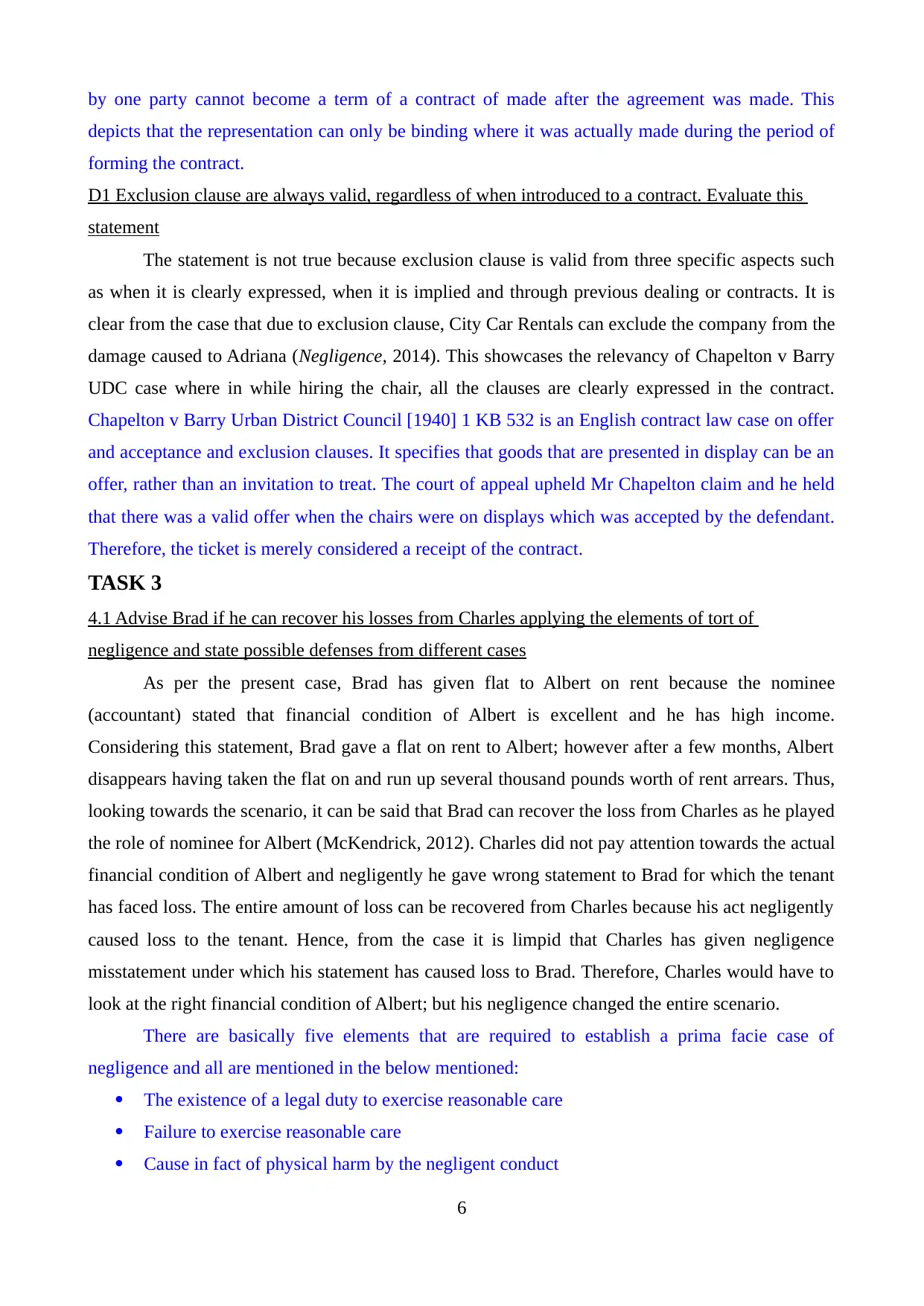
by one party cannot become a term of a contract of made after the agreement was made. This
depicts that the representation can only be binding where it was actually made during the period of
forming the contract.
D1 Exclusion clause are always valid, regardless of when introduced to a contract. Evaluate this
statement
The statement is not true because exclusion clause is valid from three specific aspects such
as when it is clearly expressed, when it is implied and through previous dealing or contracts. It is
clear from the case that due to exclusion clause, City Car Rentals can exclude the company from the
damage caused to Adriana (Negligence, 2014). This showcases the relevancy of Chapelton v Barry
UDC case where in while hiring the chair, all the clauses are clearly expressed in the contract.
Chapelton v Barry Urban District Council [1940] 1 KB 532 is an English contract law case on offer
and acceptance and exclusion clauses. It specifies that goods that are presented in display can be an
offer, rather than an invitation to treat. The court of appeal upheld Mr Chapelton claim and he held
that there was a valid offer when the chairs were on displays which was accepted by the defendant.
Therefore, the ticket is merely considered a receipt of the contract.
TASK 3
4.1 Advise Brad if he can recover his losses from Charles applying the elements of tort of
negligence and state possible defenses from different cases
As per the present case, Brad has given flat to Albert on rent because the nominee
(accountant) stated that financial condition of Albert is excellent and he has high income.
Considering this statement, Brad gave a flat on rent to Albert; however after a few months, Albert
disappears having taken the flat on and run up several thousand pounds worth of rent arrears. Thus,
looking towards the scenario, it can be said that Brad can recover the loss from Charles as he played
the role of nominee for Albert (McKendrick, 2012). Charles did not pay attention towards the actual
financial condition of Albert and negligently he gave wrong statement to Brad for which the tenant
has faced loss. The entire amount of loss can be recovered from Charles because his act negligently
caused loss to the tenant. Hence, from the case it is limpid that Charles has given negligence
misstatement under which his statement has caused loss to Brad. Therefore, Charles would have to
look at the right financial condition of Albert; but his negligence changed the entire scenario.
There are basically five elements that are required to establish a prima facie case of
negligence and all are mentioned in the below mentioned:
The existence of a legal duty to exercise reasonable care
Failure to exercise reasonable care
Cause in fact of physical harm by the negligent conduct
6
depicts that the representation can only be binding where it was actually made during the period of
forming the contract.
D1 Exclusion clause are always valid, regardless of when introduced to a contract. Evaluate this
statement
The statement is not true because exclusion clause is valid from three specific aspects such
as when it is clearly expressed, when it is implied and through previous dealing or contracts. It is
clear from the case that due to exclusion clause, City Car Rentals can exclude the company from the
damage caused to Adriana (Negligence, 2014). This showcases the relevancy of Chapelton v Barry
UDC case where in while hiring the chair, all the clauses are clearly expressed in the contract.
Chapelton v Barry Urban District Council [1940] 1 KB 532 is an English contract law case on offer
and acceptance and exclusion clauses. It specifies that goods that are presented in display can be an
offer, rather than an invitation to treat. The court of appeal upheld Mr Chapelton claim and he held
that there was a valid offer when the chairs were on displays which was accepted by the defendant.
Therefore, the ticket is merely considered a receipt of the contract.
TASK 3
4.1 Advise Brad if he can recover his losses from Charles applying the elements of tort of
negligence and state possible defenses from different cases
As per the present case, Brad has given flat to Albert on rent because the nominee
(accountant) stated that financial condition of Albert is excellent and he has high income.
Considering this statement, Brad gave a flat on rent to Albert; however after a few months, Albert
disappears having taken the flat on and run up several thousand pounds worth of rent arrears. Thus,
looking towards the scenario, it can be said that Brad can recover the loss from Charles as he played
the role of nominee for Albert (McKendrick, 2012). Charles did not pay attention towards the actual
financial condition of Albert and negligently he gave wrong statement to Brad for which the tenant
has faced loss. The entire amount of loss can be recovered from Charles because his act negligently
caused loss to the tenant. Hence, from the case it is limpid that Charles has given negligence
misstatement under which his statement has caused loss to Brad. Therefore, Charles would have to
look at the right financial condition of Albert; but his negligence changed the entire scenario.
There are basically five elements that are required to establish a prima facie case of
negligence and all are mentioned in the below mentioned:
The existence of a legal duty to exercise reasonable care
Failure to exercise reasonable care
Cause in fact of physical harm by the negligent conduct
6
⊘ This is a preview!⊘
Do you want full access?
Subscribe today to unlock all pages.

Trusted by 1+ million students worldwide
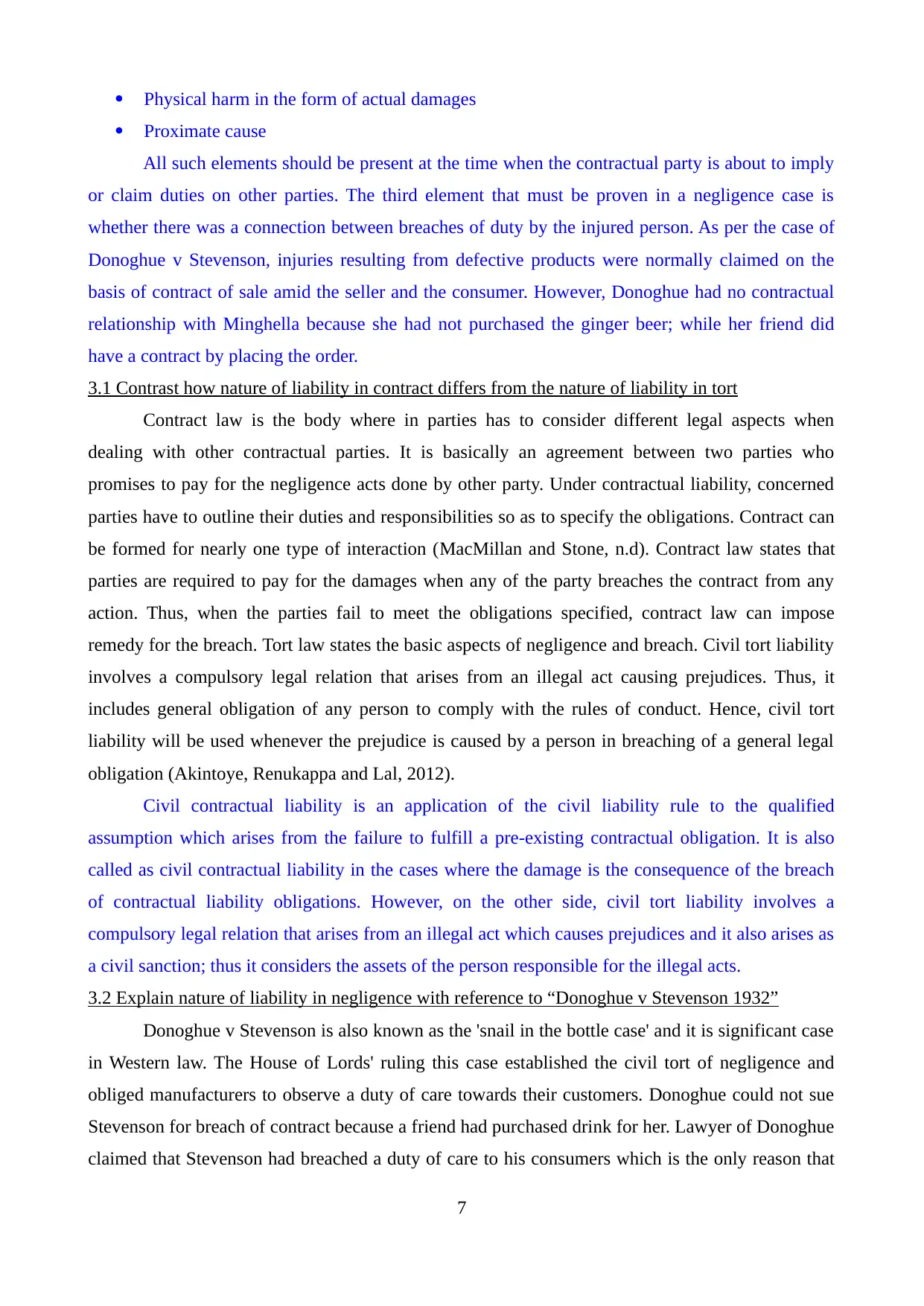
Physical harm in the form of actual damages
Proximate cause
All such elements should be present at the time when the contractual party is about to imply
or claim duties on other parties. The third element that must be proven in a negligence case is
whether there was a connection between breaches of duty by the injured person. As per the case of
Donoghue v Stevenson, injuries resulting from defective products were normally claimed on the
basis of contract of sale amid the seller and the consumer. However, Donoghue had no contractual
relationship with Minghella because she had not purchased the ginger beer; while her friend did
have a contract by placing the order.
3.1 Contrast how nature of liability in contract differs from the nature of liability in tort
Contract law is the body where in parties has to consider different legal aspects when
dealing with other contractual parties. It is basically an agreement between two parties who
promises to pay for the negligence acts done by other party. Under contractual liability, concerned
parties have to outline their duties and responsibilities so as to specify the obligations. Contract can
be formed for nearly one type of interaction (MacMillan and Stone, n.d). Contract law states that
parties are required to pay for the damages when any of the party breaches the contract from any
action. Thus, when the parties fail to meet the obligations specified, contract law can impose
remedy for the breach. Tort law states the basic aspects of negligence and breach. Civil tort liability
involves a compulsory legal relation that arises from an illegal act causing prejudices. Thus, it
includes general obligation of any person to comply with the rules of conduct. Hence, civil tort
liability will be used whenever the prejudice is caused by a person in breaching of a general legal
obligation (Akintoye, Renukappa and Lal, 2012).
Civil contractual liability is an application of the civil liability rule to the qualified
assumption which arises from the failure to fulfill a pre-existing contractual obligation. It is also
called as civil contractual liability in the cases where the damage is the consequence of the breach
of contractual liability obligations. However, on the other side, civil tort liability involves a
compulsory legal relation that arises from an illegal act which causes prejudices and it also arises as
a civil sanction; thus it considers the assets of the person responsible for the illegal acts.
3.2 Explain nature of liability in negligence with reference to “Donoghue v Stevenson 1932”
Donoghue v Stevenson is also known as the 'snail in the bottle case' and it is significant case
in Western law. The House of Lords' ruling this case established the civil tort of negligence and
obliged manufacturers to observe a duty of care towards their customers. Donoghue could not sue
Stevenson for breach of contract because a friend had purchased drink for her. Lawyer of Donoghue
claimed that Stevenson had breached a duty of care to his consumers which is the only reason that
7
Proximate cause
All such elements should be present at the time when the contractual party is about to imply
or claim duties on other parties. The third element that must be proven in a negligence case is
whether there was a connection between breaches of duty by the injured person. As per the case of
Donoghue v Stevenson, injuries resulting from defective products were normally claimed on the
basis of contract of sale amid the seller and the consumer. However, Donoghue had no contractual
relationship with Minghella because she had not purchased the ginger beer; while her friend did
have a contract by placing the order.
3.1 Contrast how nature of liability in contract differs from the nature of liability in tort
Contract law is the body where in parties has to consider different legal aspects when
dealing with other contractual parties. It is basically an agreement between two parties who
promises to pay for the negligence acts done by other party. Under contractual liability, concerned
parties have to outline their duties and responsibilities so as to specify the obligations. Contract can
be formed for nearly one type of interaction (MacMillan and Stone, n.d). Contract law states that
parties are required to pay for the damages when any of the party breaches the contract from any
action. Thus, when the parties fail to meet the obligations specified, contract law can impose
remedy for the breach. Tort law states the basic aspects of negligence and breach. Civil tort liability
involves a compulsory legal relation that arises from an illegal act causing prejudices. Thus, it
includes general obligation of any person to comply with the rules of conduct. Hence, civil tort
liability will be used whenever the prejudice is caused by a person in breaching of a general legal
obligation (Akintoye, Renukappa and Lal, 2012).
Civil contractual liability is an application of the civil liability rule to the qualified
assumption which arises from the failure to fulfill a pre-existing contractual obligation. It is also
called as civil contractual liability in the cases where the damage is the consequence of the breach
of contractual liability obligations. However, on the other side, civil tort liability involves a
compulsory legal relation that arises from an illegal act which causes prejudices and it also arises as
a civil sanction; thus it considers the assets of the person responsible for the illegal acts.
3.2 Explain nature of liability in negligence with reference to “Donoghue v Stevenson 1932”
Donoghue v Stevenson is also known as the 'snail in the bottle case' and it is significant case
in Western law. The House of Lords' ruling this case established the civil tort of negligence and
obliged manufacturers to observe a duty of care towards their customers. Donoghue could not sue
Stevenson for breach of contract because a friend had purchased drink for her. Lawyer of Donoghue
claimed that Stevenson had breached a duty of care to his consumers which is the only reason that
7
Paraphrase This Document
Need a fresh take? Get an instant paraphrase of this document with our AI Paraphraser
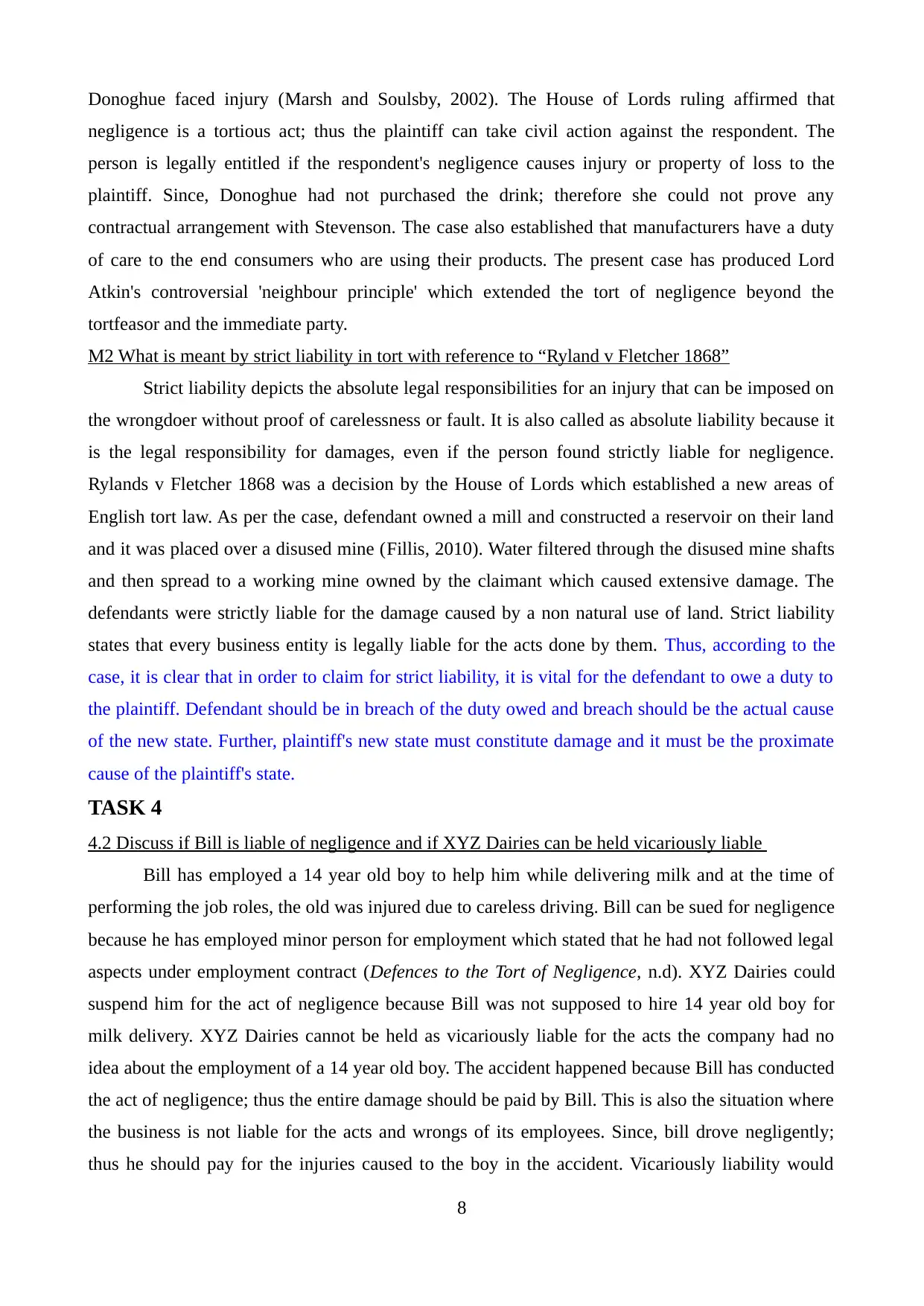
Donoghue faced injury (Marsh and Soulsby, 2002). The House of Lords ruling affirmed that
negligence is a tortious act; thus the plaintiff can take civil action against the respondent. The
person is legally entitled if the respondent's negligence causes injury or property of loss to the
plaintiff. Since, Donoghue had not purchased the drink; therefore she could not prove any
contractual arrangement with Stevenson. The case also established that manufacturers have a duty
of care to the end consumers who are using their products. The present case has produced Lord
Atkin's controversial 'neighbour principle' which extended the tort of negligence beyond the
tortfeasor and the immediate party.
M2 What is meant by strict liability in tort with reference to “Ryland v Fletcher 1868”
Strict liability depicts the absolute legal responsibilities for an injury that can be imposed on
the wrongdoer without proof of carelessness or fault. It is also called as absolute liability because it
is the legal responsibility for damages, even if the person found strictly liable for negligence.
Rylands v Fletcher 1868 was a decision by the House of Lords which established a new areas of
English tort law. As per the case, defendant owned a mill and constructed a reservoir on their land
and it was placed over a disused mine (Fillis, 2010). Water filtered through the disused mine shafts
and then spread to a working mine owned by the claimant which caused extensive damage. The
defendants were strictly liable for the damage caused by a non natural use of land. Strict liability
states that every business entity is legally liable for the acts done by them. Thus, according to the
case, it is clear that in order to claim for strict liability, it is vital for the defendant to owe a duty to
the plaintiff. Defendant should be in breach of the duty owed and breach should be the actual cause
of the new state. Further, plaintiff's new state must constitute damage and it must be the proximate
cause of the plaintiff's state.
TASK 4
4.2 Discuss if Bill is liable of negligence and if XYZ Dairies can be held vicariously liable
Bill has employed a 14 year old boy to help him while delivering milk and at the time of
performing the job roles, the old was injured due to careless driving. Bill can be sued for negligence
because he has employed minor person for employment which stated that he had not followed legal
aspects under employment contract (Defences to the Tort of Negligence, n.d). XYZ Dairies could
suspend him for the act of negligence because Bill was not supposed to hire 14 year old boy for
milk delivery. XYZ Dairies cannot be held as vicariously liable for the acts the company had no
idea about the employment of a 14 year old boy. The accident happened because Bill has conducted
the act of negligence; thus the entire damage should be paid by Bill. This is also the situation where
the business is not liable for the acts and wrongs of its employees. Since, bill drove negligently;
thus he should pay for the injuries caused to the boy in the accident. Vicariously liability would
8
negligence is a tortious act; thus the plaintiff can take civil action against the respondent. The
person is legally entitled if the respondent's negligence causes injury or property of loss to the
plaintiff. Since, Donoghue had not purchased the drink; therefore she could not prove any
contractual arrangement with Stevenson. The case also established that manufacturers have a duty
of care to the end consumers who are using their products. The present case has produced Lord
Atkin's controversial 'neighbour principle' which extended the tort of negligence beyond the
tortfeasor and the immediate party.
M2 What is meant by strict liability in tort with reference to “Ryland v Fletcher 1868”
Strict liability depicts the absolute legal responsibilities for an injury that can be imposed on
the wrongdoer without proof of carelessness or fault. It is also called as absolute liability because it
is the legal responsibility for damages, even if the person found strictly liable for negligence.
Rylands v Fletcher 1868 was a decision by the House of Lords which established a new areas of
English tort law. As per the case, defendant owned a mill and constructed a reservoir on their land
and it was placed over a disused mine (Fillis, 2010). Water filtered through the disused mine shafts
and then spread to a working mine owned by the claimant which caused extensive damage. The
defendants were strictly liable for the damage caused by a non natural use of land. Strict liability
states that every business entity is legally liable for the acts done by them. Thus, according to the
case, it is clear that in order to claim for strict liability, it is vital for the defendant to owe a duty to
the plaintiff. Defendant should be in breach of the duty owed and breach should be the actual cause
of the new state. Further, plaintiff's new state must constitute damage and it must be the proximate
cause of the plaintiff's state.
TASK 4
4.2 Discuss if Bill is liable of negligence and if XYZ Dairies can be held vicariously liable
Bill has employed a 14 year old boy to help him while delivering milk and at the time of
performing the job roles, the old was injured due to careless driving. Bill can be sued for negligence
because he has employed minor person for employment which stated that he had not followed legal
aspects under employment contract (Defences to the Tort of Negligence, n.d). XYZ Dairies could
suspend him for the act of negligence because Bill was not supposed to hire 14 year old boy for
milk delivery. XYZ Dairies cannot be held as vicariously liable for the acts the company had no
idea about the employment of a 14 year old boy. The accident happened because Bill has conducted
the act of negligence; thus the entire damage should be paid by Bill. This is also the situation where
the business is not liable for the acts and wrongs of its employees. Since, bill drove negligently;
thus he should pay for the injuries caused to the boy in the accident. Vicariously liability would
8
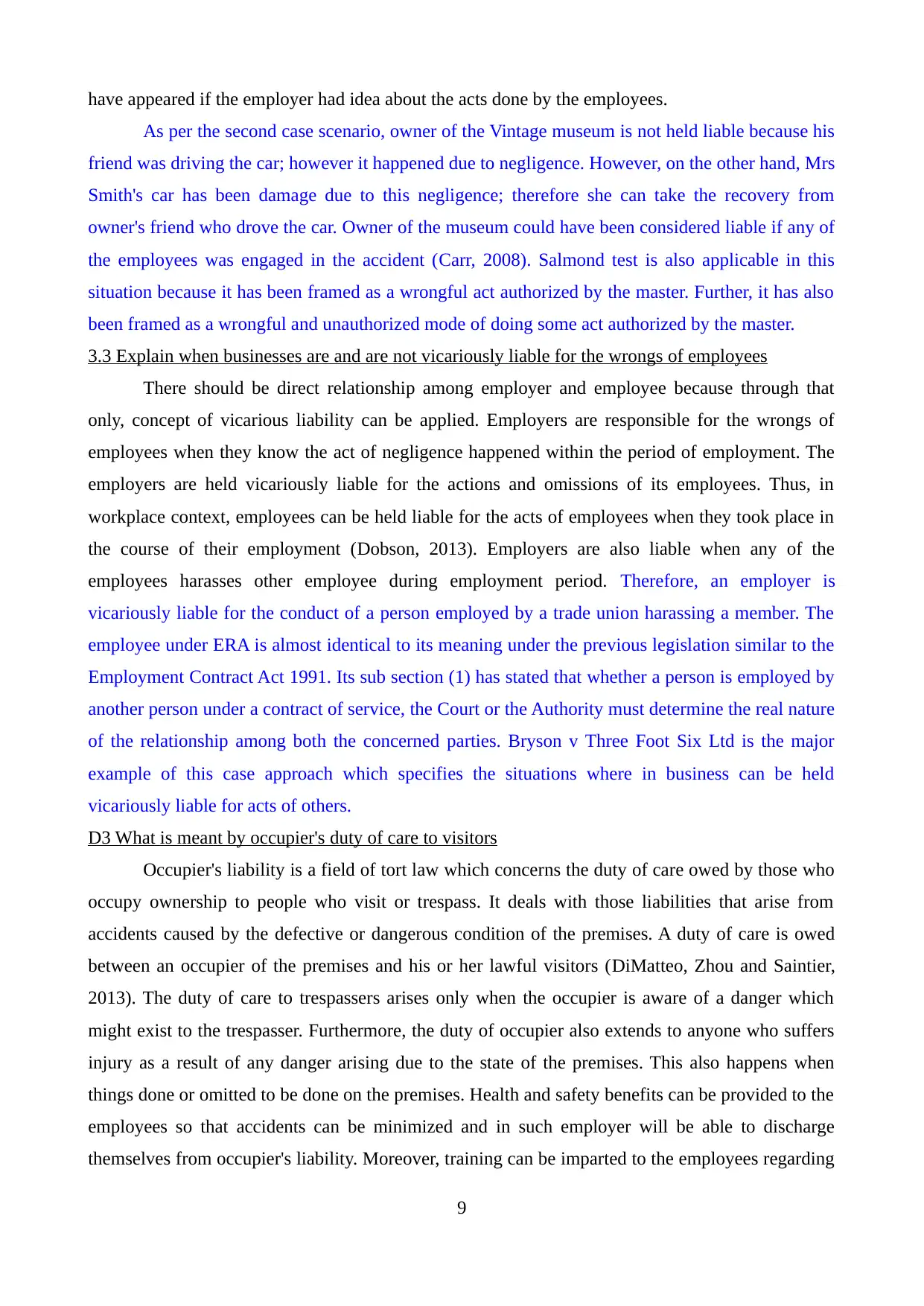
have appeared if the employer had idea about the acts done by the employees.
As per the second case scenario, owner of the Vintage museum is not held liable because his
friend was driving the car; however it happened due to negligence. However, on the other hand, Mrs
Smith's car has been damage due to this negligence; therefore she can take the recovery from
owner's friend who drove the car. Owner of the museum could have been considered liable if any of
the employees was engaged in the accident (Carr, 2008). Salmond test is also applicable in this
situation because it has been framed as a wrongful act authorized by the master. Further, it has also
been framed as a wrongful and unauthorized mode of doing some act authorized by the master.
3.3 Explain when businesses are and are not vicariously liable for the wrongs of employees
There should be direct relationship among employer and employee because through that
only, concept of vicarious liability can be applied. Employers are responsible for the wrongs of
employees when they know the act of negligence happened within the period of employment. The
employers are held vicariously liable for the actions and omissions of its employees. Thus, in
workplace context, employees can be held liable for the acts of employees when they took place in
the course of their employment (Dobson, 2013). Employers are also liable when any of the
employees harasses other employee during employment period. Therefore, an employer is
vicariously liable for the conduct of a person employed by a trade union harassing a member. The
employee under ERA is almost identical to its meaning under the previous legislation similar to the
Employment Contract Act 1991. Its sub section (1) has stated that whether a person is employed by
another person under a contract of service, the Court or the Authority must determine the real nature
of the relationship among both the concerned parties. Bryson v Three Foot Six Ltd is the major
example of this case approach which specifies the situations where in business can be held
vicariously liable for acts of others.
D3 What is meant by occupier's duty of care to visitors
Occupier's liability is a field of tort law which concerns the duty of care owed by those who
occupy ownership to people who visit or trespass. It deals with those liabilities that arise from
accidents caused by the defective or dangerous condition of the premises. A duty of care is owed
between an occupier of the premises and his or her lawful visitors (DiMatteo, Zhou and Saintier,
2013). The duty of care to trespassers arises only when the occupier is aware of a danger which
might exist to the trespasser. Furthermore, the duty of occupier also extends to anyone who suffers
injury as a result of any danger arising due to the state of the premises. This also happens when
things done or omitted to be done on the premises. Health and safety benefits can be provided to the
employees so that accidents can be minimized and in such employer will be able to discharge
themselves from occupier's liability. Moreover, training can be imparted to the employees regarding
9
As per the second case scenario, owner of the Vintage museum is not held liable because his
friend was driving the car; however it happened due to negligence. However, on the other hand, Mrs
Smith's car has been damage due to this negligence; therefore she can take the recovery from
owner's friend who drove the car. Owner of the museum could have been considered liable if any of
the employees was engaged in the accident (Carr, 2008). Salmond test is also applicable in this
situation because it has been framed as a wrongful act authorized by the master. Further, it has also
been framed as a wrongful and unauthorized mode of doing some act authorized by the master.
3.3 Explain when businesses are and are not vicariously liable for the wrongs of employees
There should be direct relationship among employer and employee because through that
only, concept of vicarious liability can be applied. Employers are responsible for the wrongs of
employees when they know the act of negligence happened within the period of employment. The
employers are held vicariously liable for the actions and omissions of its employees. Thus, in
workplace context, employees can be held liable for the acts of employees when they took place in
the course of their employment (Dobson, 2013). Employers are also liable when any of the
employees harasses other employee during employment period. Therefore, an employer is
vicariously liable for the conduct of a person employed by a trade union harassing a member. The
employee under ERA is almost identical to its meaning under the previous legislation similar to the
Employment Contract Act 1991. Its sub section (1) has stated that whether a person is employed by
another person under a contract of service, the Court or the Authority must determine the real nature
of the relationship among both the concerned parties. Bryson v Three Foot Six Ltd is the major
example of this case approach which specifies the situations where in business can be held
vicariously liable for acts of others.
D3 What is meant by occupier's duty of care to visitors
Occupier's liability is a field of tort law which concerns the duty of care owed by those who
occupy ownership to people who visit or trespass. It deals with those liabilities that arise from
accidents caused by the defective or dangerous condition of the premises. A duty of care is owed
between an occupier of the premises and his or her lawful visitors (DiMatteo, Zhou and Saintier,
2013). The duty of care to trespassers arises only when the occupier is aware of a danger which
might exist to the trespasser. Furthermore, the duty of occupier also extends to anyone who suffers
injury as a result of any danger arising due to the state of the premises. This also happens when
things done or omitted to be done on the premises. Health and safety benefits can be provided to the
employees so that accidents can be minimized and in such employer will be able to discharge
themselves from occupier's liability. Moreover, training can be imparted to the employees regarding
9
⊘ This is a preview!⊘
Do you want full access?
Subscribe today to unlock all pages.

Trusted by 1+ million students worldwide
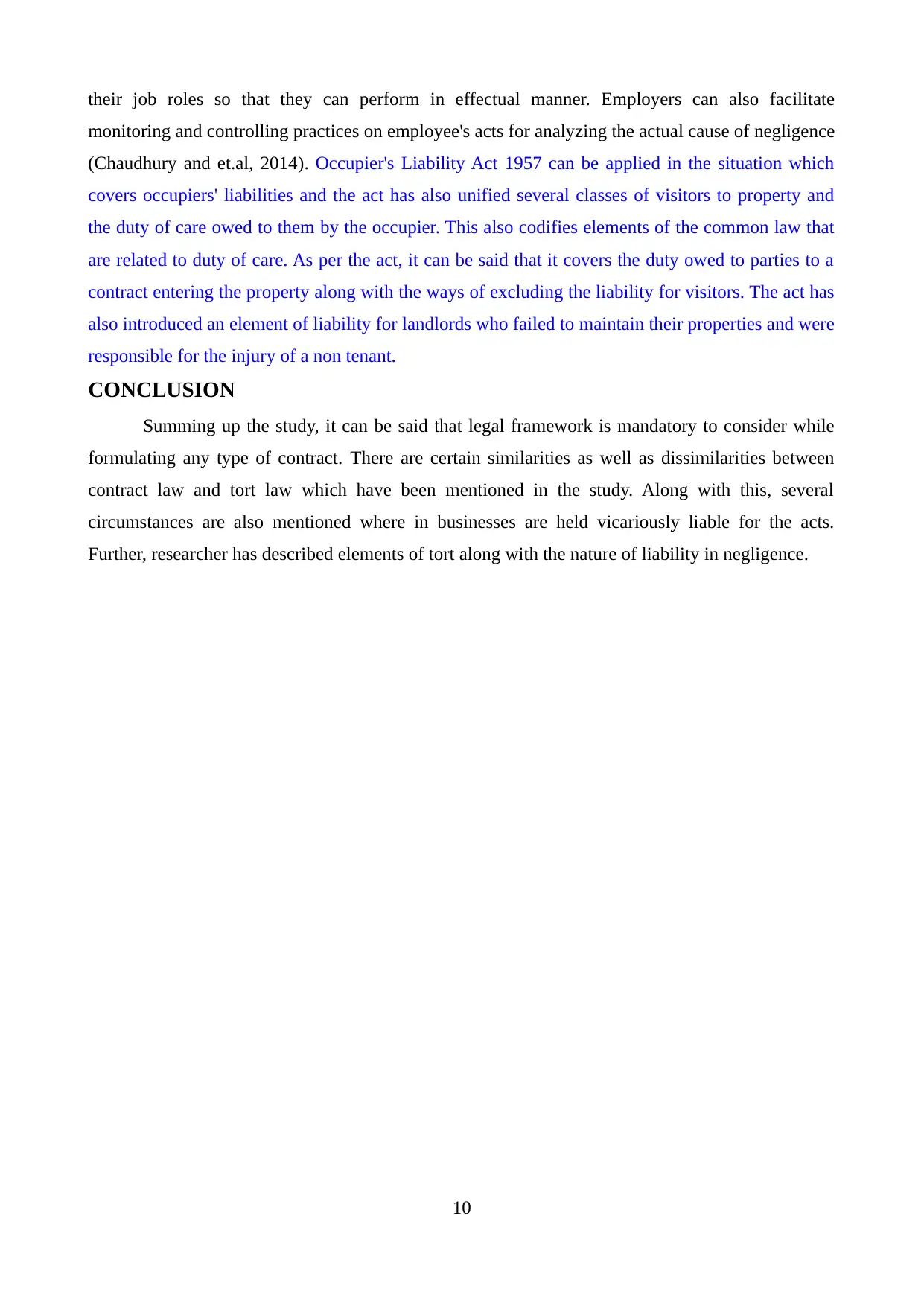
their job roles so that they can perform in effectual manner. Employers can also facilitate
monitoring and controlling practices on employee's acts for analyzing the actual cause of negligence
(Chaudhury and et.al, 2014). Occupier's Liability Act 1957 can be applied in the situation which
covers occupiers' liabilities and the act has also unified several classes of visitors to property and
the duty of care owed to them by the occupier. This also codifies elements of the common law that
are related to duty of care. As per the act, it can be said that it covers the duty owed to parties to a
contract entering the property along with the ways of excluding the liability for visitors. The act has
also introduced an element of liability for landlords who failed to maintain their properties and were
responsible for the injury of a non tenant.
CONCLUSION
Summing up the study, it can be said that legal framework is mandatory to consider while
formulating any type of contract. There are certain similarities as well as dissimilarities between
contract law and tort law which have been mentioned in the study. Along with this, several
circumstances are also mentioned where in businesses are held vicariously liable for the acts.
Further, researcher has described elements of tort along with the nature of liability in negligence.
10
monitoring and controlling practices on employee's acts for analyzing the actual cause of negligence
(Chaudhury and et.al, 2014). Occupier's Liability Act 1957 can be applied in the situation which
covers occupiers' liabilities and the act has also unified several classes of visitors to property and
the duty of care owed to them by the occupier. This also codifies elements of the common law that
are related to duty of care. As per the act, it can be said that it covers the duty owed to parties to a
contract entering the property along with the ways of excluding the liability for visitors. The act has
also introduced an element of liability for landlords who failed to maintain their properties and were
responsible for the injury of a non tenant.
CONCLUSION
Summing up the study, it can be said that legal framework is mandatory to consider while
formulating any type of contract. There are certain similarities as well as dissimilarities between
contract law and tort law which have been mentioned in the study. Along with this, several
circumstances are also mentioned where in businesses are held vicariously liable for the acts.
Further, researcher has described elements of tort along with the nature of liability in negligence.
10
Paraphrase This Document
Need a fresh take? Get an instant paraphrase of this document with our AI Paraphraser
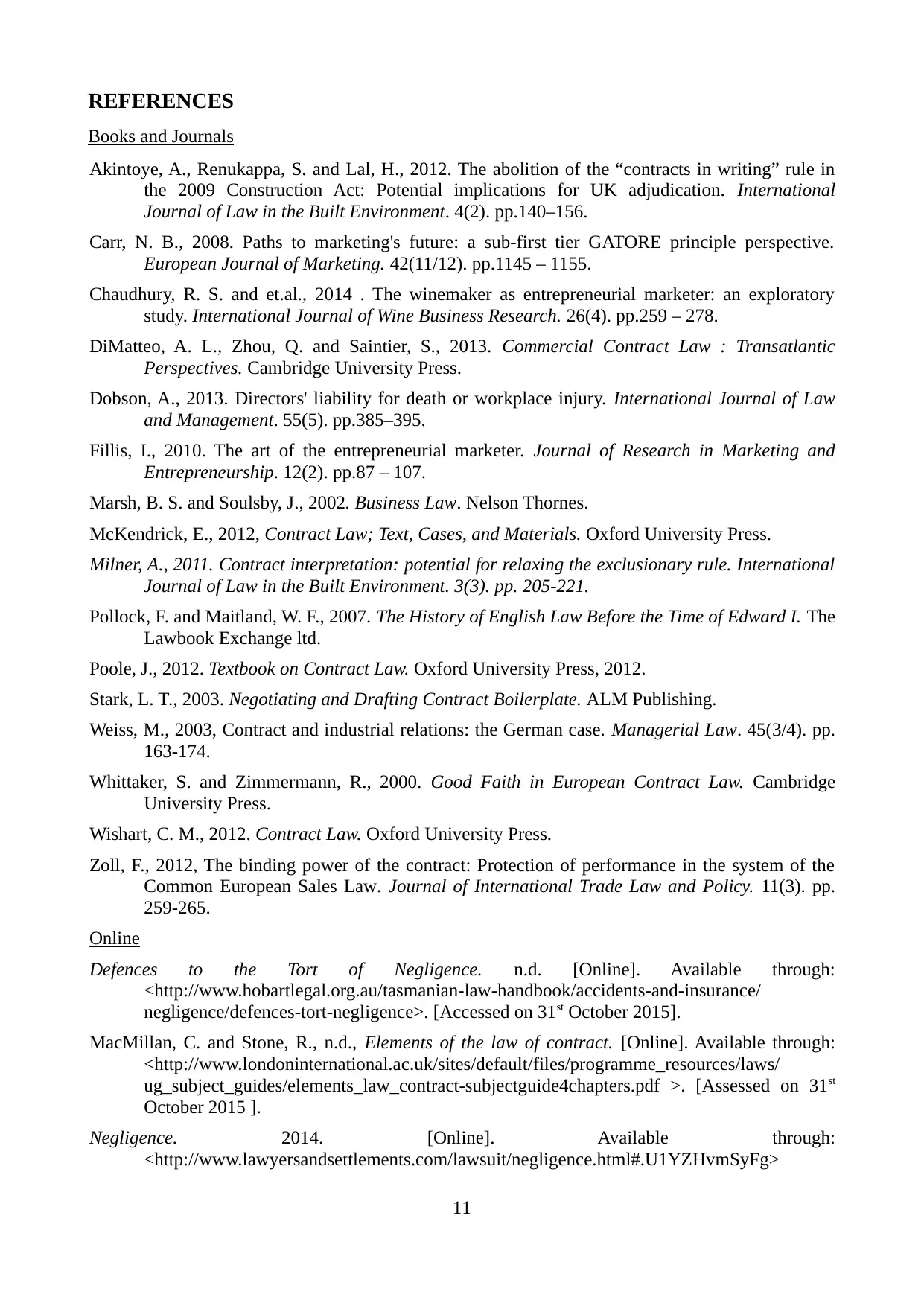
REFERENCES
Books and Journals
Akintoye, A., Renukappa, S. and Lal, H., 2012. The abolition of the “contracts in writing” rule in
the 2009 Construction Act: Potential implications for UK adjudication. International
Journal of Law in the Built Environment. 4(2). pp.140–156.
Carr, N. B., 2008. Paths to marketing's future: a sub‐first tier GATORE principle perspective.
European Journal of Marketing. 42(11/12). pp.1145 – 1155.
Chaudhury, R. S. and et.al., 2014 . The winemaker as entrepreneurial marketer: an exploratory
study. International Journal of Wine Business Research. 26(4). pp.259 – 278.
DiMatteo, A. L., Zhou, Q. and Saintier, S., 2013. Commercial Contract Law : Transatlantic
Perspectives. Cambridge University Press.
Dobson, A., 2013. Directors' liability for death or workplace injury. International Journal of Law
and Management. 55(5). pp.385–395.
Fillis, I., 2010. The art of the entrepreneurial marketer. Journal of Research in Marketing and
Entrepreneurship. 12(2). pp.87 – 107.
Marsh, B. S. and Soulsby, J., 2002. Business Law. Nelson Thornes.
McKendrick, E., 2012, Contract Law; Text, Cases, and Materials. Oxford University Press.
Milner, A., 2011. Contract interpretation: potential for relaxing the exclusionary rule. International
Journal of Law in the Built Environment. 3(3). pp. 205-221.
Pollock, F. and Maitland, W. F., 2007. The History of English Law Before the Time of Edward I. The
Lawbook Exchange ltd.
Poole, J., 2012. Textbook on Contract Law. Oxford University Press, 2012.
Stark, L. T., 2003. Negotiating and Drafting Contract Boilerplate. ALM Publishing.
Weiss, M., 2003, Contract and industrial relations: the German case. Managerial Law. 45(3/4). pp.
163-174.
Whittaker, S. and Zimmermann, R., 2000. Good Faith in European Contract Law. Cambridge
University Press.
Wishart, C. M., 2012. Contract Law. Oxford University Press.
Zoll, F., 2012, The binding power of the contract: Protection of performance in the system of the
Common European Sales Law. Journal of International Trade Law and Policy. 11(3). pp.
259-265.
Online
Defences to the Tort of Negligence. n.d. [Online]. Available through:
<http://www.hobartlegal.org.au/tasmanian-law-handbook/accidents-and-insurance/
negligence/defences-tort-negligence>. [Accessed on 31st October 2015].
MacMillan, C. and Stone, R., n.d., Elements of the law of contract. [Online]. Available through:
<http://www.londoninternational.ac.uk/sites/default/files/programme_resources/laws/
ug_subject_guides/elements_law_contract-subjectguide4chapters.pdf >. [Assessed on 31st
October 2015 ].
Negligence. 2014. [Online]. Available through:
<http://www.lawyersandsettlements.com/lawsuit/negligence.html#.U1YZHvmSyFg>
11
Books and Journals
Akintoye, A., Renukappa, S. and Lal, H., 2012. The abolition of the “contracts in writing” rule in
the 2009 Construction Act: Potential implications for UK adjudication. International
Journal of Law in the Built Environment. 4(2). pp.140–156.
Carr, N. B., 2008. Paths to marketing's future: a sub‐first tier GATORE principle perspective.
European Journal of Marketing. 42(11/12). pp.1145 – 1155.
Chaudhury, R. S. and et.al., 2014 . The winemaker as entrepreneurial marketer: an exploratory
study. International Journal of Wine Business Research. 26(4). pp.259 – 278.
DiMatteo, A. L., Zhou, Q. and Saintier, S., 2013. Commercial Contract Law : Transatlantic
Perspectives. Cambridge University Press.
Dobson, A., 2013. Directors' liability for death or workplace injury. International Journal of Law
and Management. 55(5). pp.385–395.
Fillis, I., 2010. The art of the entrepreneurial marketer. Journal of Research in Marketing and
Entrepreneurship. 12(2). pp.87 – 107.
Marsh, B. S. and Soulsby, J., 2002. Business Law. Nelson Thornes.
McKendrick, E., 2012, Contract Law; Text, Cases, and Materials. Oxford University Press.
Milner, A., 2011. Contract interpretation: potential for relaxing the exclusionary rule. International
Journal of Law in the Built Environment. 3(3). pp. 205-221.
Pollock, F. and Maitland, W. F., 2007. The History of English Law Before the Time of Edward I. The
Lawbook Exchange ltd.
Poole, J., 2012. Textbook on Contract Law. Oxford University Press, 2012.
Stark, L. T., 2003. Negotiating and Drafting Contract Boilerplate. ALM Publishing.
Weiss, M., 2003, Contract and industrial relations: the German case. Managerial Law. 45(3/4). pp.
163-174.
Whittaker, S. and Zimmermann, R., 2000. Good Faith in European Contract Law. Cambridge
University Press.
Wishart, C. M., 2012. Contract Law. Oxford University Press.
Zoll, F., 2012, The binding power of the contract: Protection of performance in the system of the
Common European Sales Law. Journal of International Trade Law and Policy. 11(3). pp.
259-265.
Online
Defences to the Tort of Negligence. n.d. [Online]. Available through:
<http://www.hobartlegal.org.au/tasmanian-law-handbook/accidents-and-insurance/
negligence/defences-tort-negligence>. [Accessed on 31st October 2015].
MacMillan, C. and Stone, R., n.d., Elements of the law of contract. [Online]. Available through:
<http://www.londoninternational.ac.uk/sites/default/files/programme_resources/laws/
ug_subject_guides/elements_law_contract-subjectguide4chapters.pdf >. [Assessed on 31st
October 2015 ].
Negligence. 2014. [Online]. Available through:
<http://www.lawyersandsettlements.com/lawsuit/negligence.html#.U1YZHvmSyFg>
11
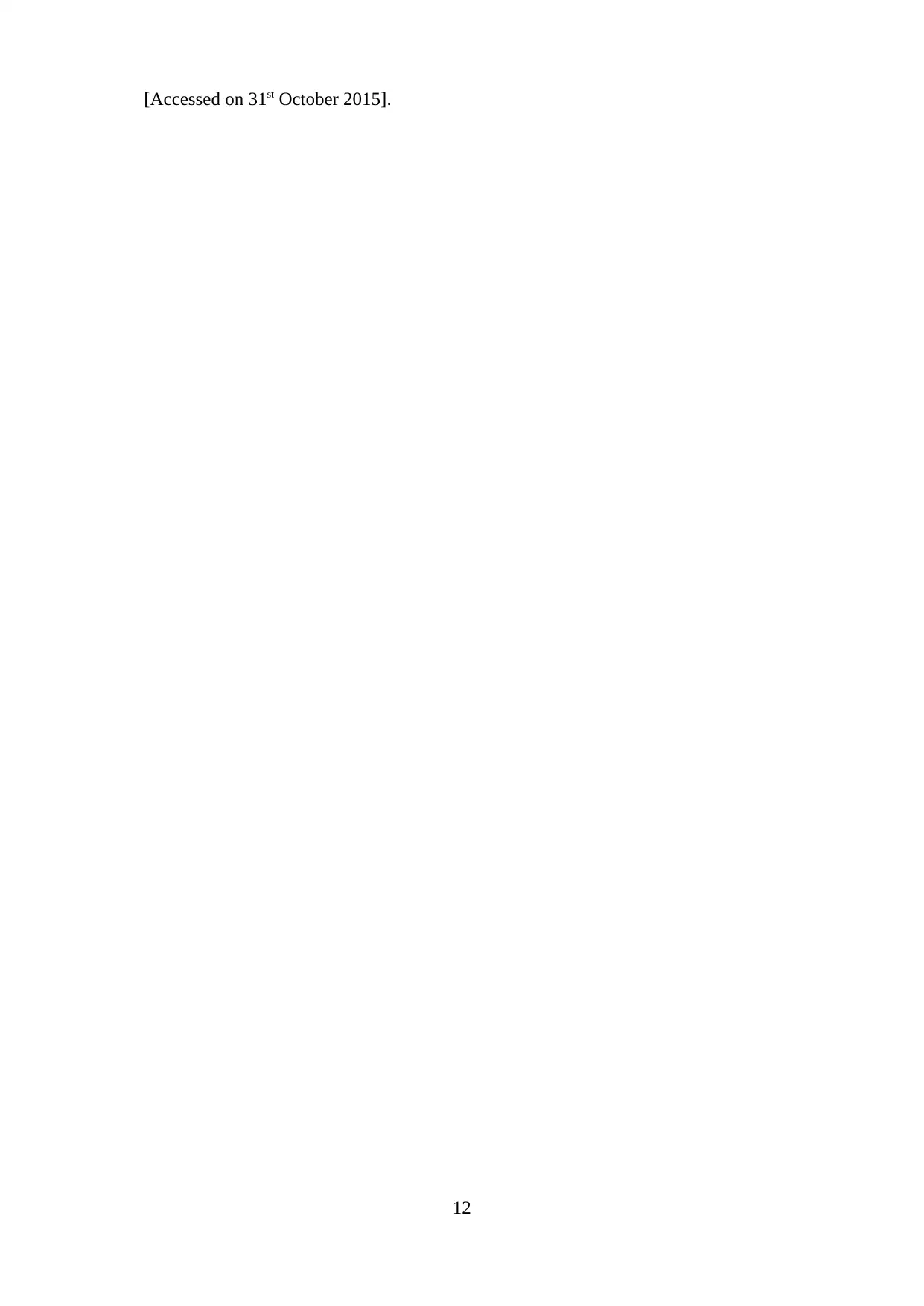
[Accessed on 31st October 2015].
12
12
⊘ This is a preview!⊘
Do you want full access?
Subscribe today to unlock all pages.

Trusted by 1+ million students worldwide
1 out of 12
Related Documents
Your All-in-One AI-Powered Toolkit for Academic Success.
+13062052269
info@desklib.com
Available 24*7 on WhatsApp / Email
![[object Object]](/_next/static/media/star-bottom.7253800d.svg)
Unlock your academic potential
Copyright © 2020–2025 A2Z Services. All Rights Reserved. Developed and managed by ZUCOL.





